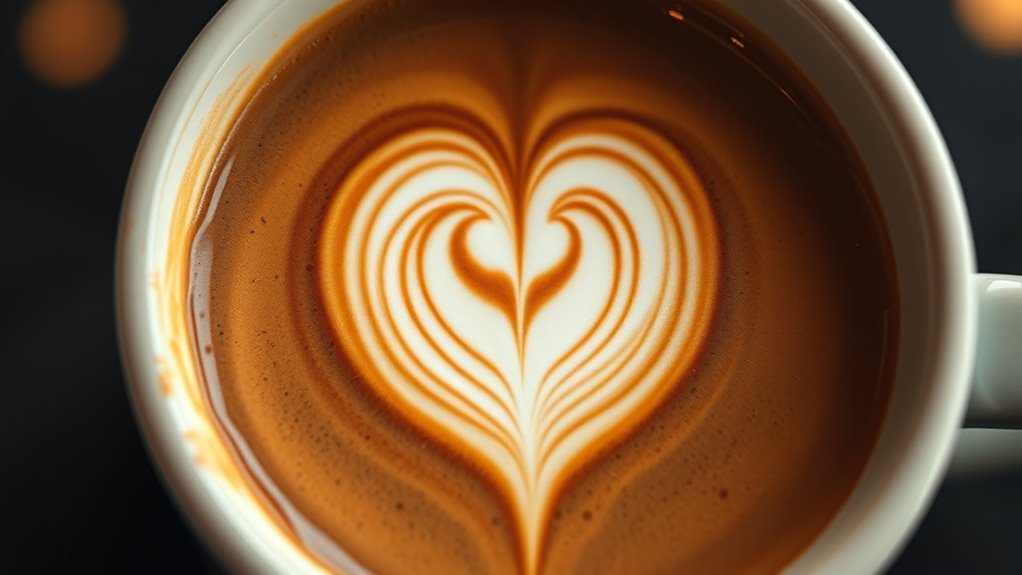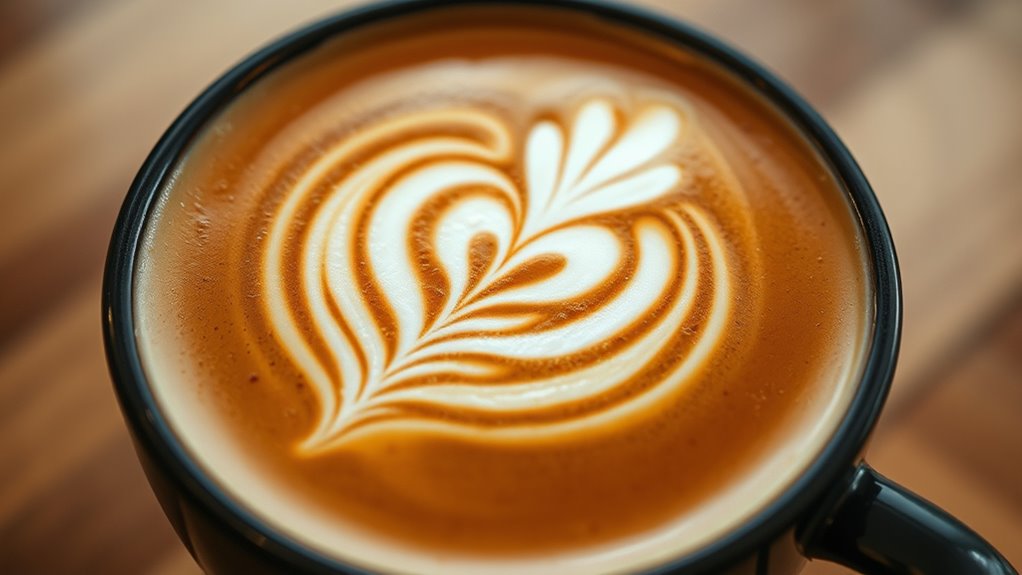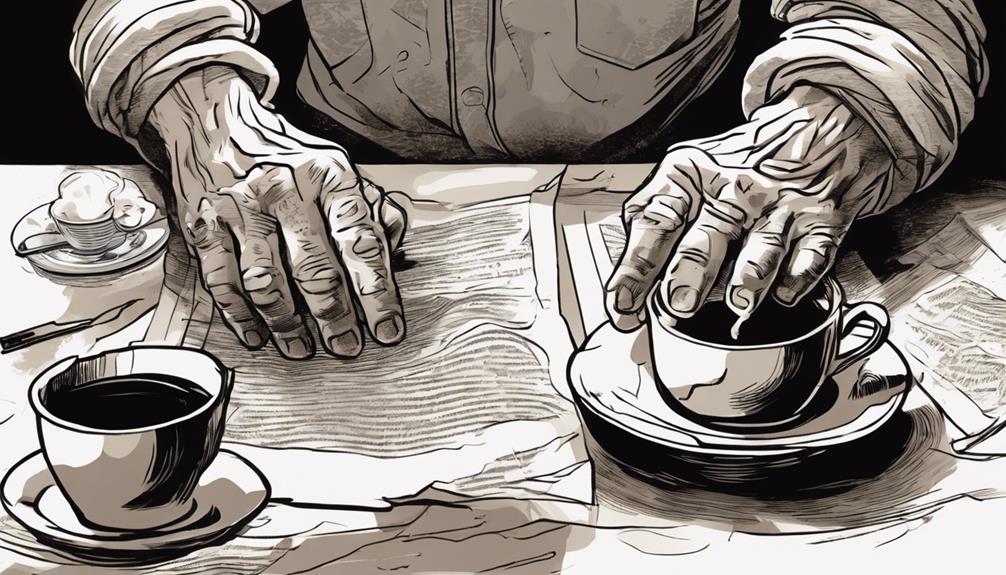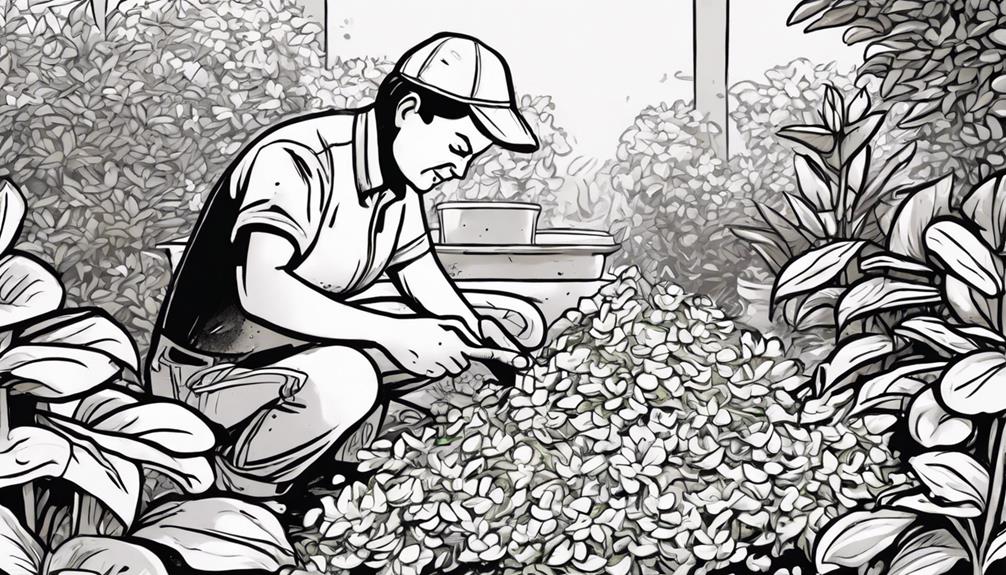Latte art transforms your coffee into a beautiful canvas, showcasing skill, creativity, and precision. As you pour steamed milk into espresso, you create intricate patterns like hearts and rosettas with smooth, glossy microfoam. The fleeting designs highlight the barista’s talent and attention to detail and make your coffee experience memorable. The beauty lies in the artistry and craftsmanship behind each pattern. If you continue, you’ll discover what makes latte art truly mesmerizing.
Key Takeaways
- Latte art transforms simple coffee into a visually captivating and artistic masterpiece.
- The quality of microfoam is essential for creating clear, sharp, and beautiful patterns.
- Precise pouring techniques allow baristas to craft intricate designs like hearts, rosettas, and tulips.
- The fleeting nature of latte art emphasizes the skill and artistry involved in its creation.
- Beautiful latte art enhances the coffee experience, showcasing craftsmanship and elevating aesthetic appeal.

Latte art transforms a simple cup of coffee into a visual masterpiece by pouring steamed milk into espresso to create intricate patterns like hearts, rosettas, and tulips on the foam surface. This art form relies heavily on the quality of milk foam, which must be smooth, glossy, and velvety—known as microfoam. When you pour milk just right, the foam blends seamlessly with the espresso’s crema, forming a canvas for your designs. The contrast between the shiny microfoam and the dark espresso beneath enhances the visual appeal, making each cup a work of art on top.
Latte art transforms coffee into a visual masterpiece with smooth microfoam and intricate patterns.
Pouring latte art isn’t just about aesthetics; it’s a skill that requires precision and control. The barista must master how to pour milk at the right temperature and consistency, ensuring the foam is thick enough to hold shapes but fluid enough to flow smoothly. The technique involves carefully controlling the pour, starting with a steady stream to build a base, then adjusting the flow to guide the milk into specific patterns. It’s a delicate balance—too fast or too slow, and the design can lose its sharpness or fail to form entirely.
Achieving a perfect art on top often takes hours of practice, as each pour demands a keen eye and steady hand. The visual appeal of latte art is fleeting, typically lasting only a few minutes before the foam begins to dissipate. That transient nature adds to its charm, emphasizing the skill and artistry behind each pour.
When you see a well-crafted pattern, you’re witnessing not just coffee art but a reflection of the barista’s dedication and finesse. The symmetry, contrast, and central placement of the design are the key criteria judges use to evaluate quality. Every perfect heart or rosetta showcases the barista’s ability to manipulate the foam and pour milk with precision.
Creating latte art elevates a simple coffee experience into a moment of visual delight. It transforms an ordinary beverage into an expressive, edible canvas. The art on top isn’t just decorative—it’s a testament to the barista’s craftsmanship and passion. With each pour of milk, you’re witnessing a fleeting masterpiece that combines technique, timing, and an eye for beauty, making each cup unique and memorable. Additionally, mastering microfoam is essential, as it directly affects the quality and clarity of the designs you can create.
Frequently Asked Questions
Why Do People Love Latte Art?
You love latte art because it transforms your coffee into a work of art, making your experience more visually appealing. It shows the skill and care of the barista, adding a sense of craftsmanship.
The fleeting beauty encourages you to savor the moment and appreciate the artistry involved. Sharing your latte art on social media connects you with others who admire this creative expression, making your coffee moments more memorable.
What Is a Fun Fact About Latte Art?
A fun fact about latte art is that some baristas have created incredibly large and intricate designs, like the world’s biggest mosaic covering over 1,000 square meters in Japan.
You might be surprised to learn that skilled artists even craft 3-D latte art that looks like it jumps out of the cup. These creative displays show just how talented and imaginative baristas can be, turning a simple coffee into a stunning piece of art.
What Are the Three Features of Great Latte Art?
Great latte art features high contrast between the microfoam and espresso crema, making your patterns stand out sharply. You should aim for symmetry and balance, ensuring your design is centered and proportionate.
Additionally, focus on creating crisp, well-defined lines and shapes, which show your precise control during pouring. These three features—contrast, symmetry, and clarity—combine to make your latte art truly impressive and visually appealing.
What Is the Science Behind Latte Art?
The science behind latte art involves understanding how microfoam interacts with espresso crema. You control the pour height, speed, and position to influence fluid dynamics, guiding the microfoam into patterns.
The chemistry of steamed milk affects foam stability, while physics like surface tension and fluid flow shape the design. By mastering these elements, you create sharp, beautiful latte art that relies on precise scientific principles.
Conclusion
You now see how latte art transforms a simple coffee into a work of art. With a little practice, you can impress friends and elevate your mornings. It’s not just about the design; it’s about enjoying the craft and the moment. So, next time you brew, try adding your own touch. Embrace the beauty of latte art, and turn every cup into a delightful experience worth sharing.









